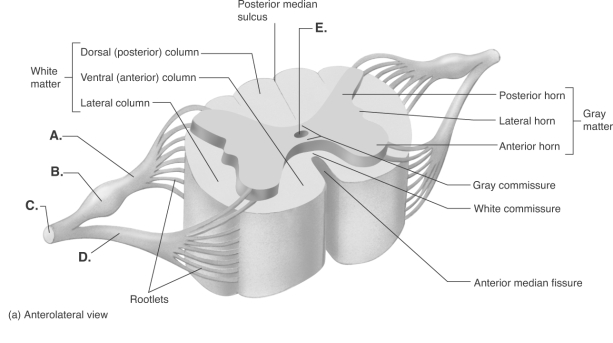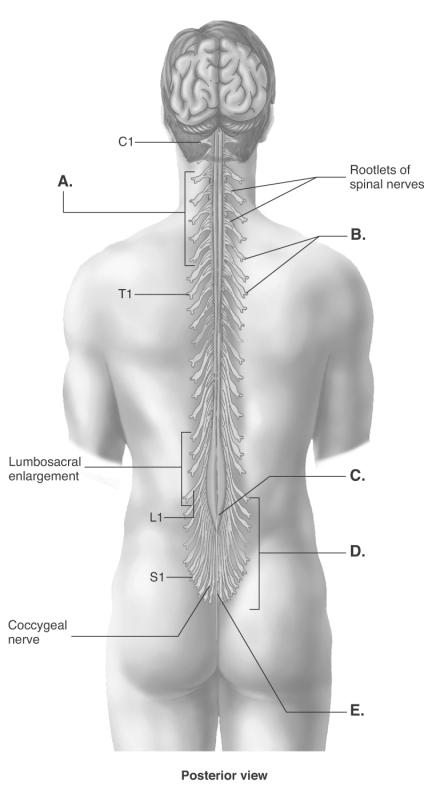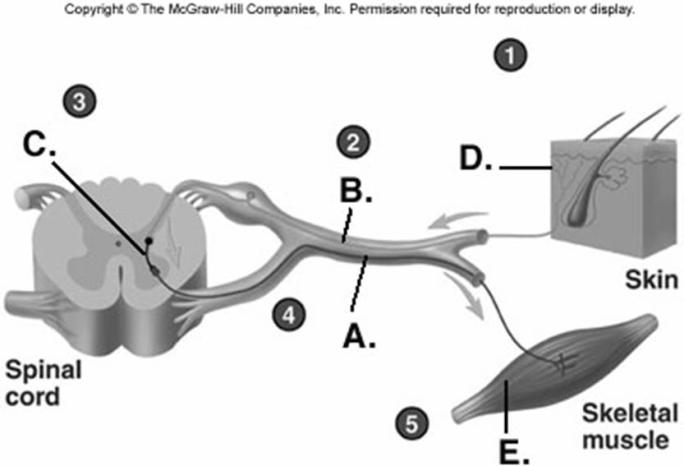A) innervates the iliopsoas, sartorius, and quadriceps femoris
B) innervates muscles of the pelvic floor
C) innervates the muscles that adduct the thigh
D) innervates the anterior and lateral muscles of the leg
E) branches to form the medial and lateral plantar nerves
Correct Answer

verified
Correct Answer
verified
Multiple Choice
 -What does "A" represent?
-What does "A" represent?
A) central canal
B) ventral root
C) dorsal root ganglion
D) spinal nerve
E) dorsal root
Correct Answer

verified
Correct Answer
verified
Multiple Choice
Match the nerve with the appropriate description. -tibial nerve
A) innervates the iliopsoas, sartorius, and quadriceps femoris
B) innervates muscles of the pelvic floor
C) innervates the muscles that adduct the thigh
D) innervates the anterior and lateral muscles of the leg
E) branches to form the medial and lateral plantar nerves
Correct Answer

verified
Correct Answer
verified
Multiple Choice
During a spinal tap, cerebrospinal fluid is obtained from which of the following locations?
A) dural sinus
B) epidural space
C) subarachnoid space
D) subdural space
E) sagittal sinus
Correct Answer

verified
Correct Answer
verified
Multiple Choice
An injury to the wrist that results in edema in the carpal tunnel would compress the
A) axillary nerve.
B) radial nerve.
C) musculocutaneous nerve.
D) ulnar nerve.
E) median nerve.
Correct Answer

verified
Correct Answer
verified
Multiple Choice
The adaptive significance of the crossed extensor reflex when a person steps on a tack is to
A) remove the foot from the tack.
B) increase the rate at which withdrawal of the limb occurs.
C) slow the rate of removal of the foot from the tack.
D) reduce the pain sensations.
E) prevent the person from falling down.
Correct Answer

verified
Correct Answer
verified
Multiple Choice
Match the term with the correct definition. -dura mater
A) functional unit of the nervous system
B) most superficial and thickest meninx
C) the middle meninx
D) the meninx bound tightly to brain and spinal cord
E) separates dura mater from periosteum
Correct Answer

verified
Correct Answer
verified
Multiple Choice
Spinal nerves exiting the cord from the level of L4 to S4 form the
A) lumbar plexus.
B) femoral plexus.
C) sacral plexus.
D) pelvic plexus.
E) brachial plexus.
Correct Answer

verified
Correct Answer
verified
Multiple Choice
Which of the following nerves is a branch of both the cervical plexus and the brachial plexus?
A) axillary
B) femoral
C) phrenic
D) sciatic
E) splanchnic
Correct Answer

verified
Correct Answer
verified
Multiple Choice
Match the disorder with its description. -anesthesia
A) pain radiating down the back of the thigh and leg
B) stiffness in the neck and headache
C) inflammation of a nerve
D) pain along a nerve tract
E) loss of sensation
Correct Answer

verified
Correct Answer
verified
Multiple Choice
Stimulation of the Golgi tendon organs result in which of the following changes in the reflex arc?
A) stimulation of a stimulatory association neuron
B) stimulation of an inhibitory neuron
C) decreased action potentials in alpha motor neurons
D) contraction of skeletal muscle fibers
E) stimulation of an inhibitory neuron and decreased action potentials in alpha motor neurons
Correct Answer

verified
Correct Answer
verified
Short Answer
The largest peripheral nerve in the body is the ______ nerve.
Correct Answer

verified
Correct Answer
verified
Multiple Choice
 -What does "C" represent?
-What does "C" represent?
A) spinal nerves
B) conus medullaris
C) cervical enlargement
D) filium terminale
E) cauda equina
Correct Answer

verified
Correct Answer
verified
Multiple Choice
 -What does "D" represent?
-What does "D" represent?
A) spinal nerves
B) conus medullaris
C) cervical enlargement
D) filium terminale
E) cauda equina
Correct Answer

verified
Correct Answer
verified
Short Answer
In the PNS, nerves are held together by
Correct Answer

verified
Correct Answer
verified
Multiple Choice
When someone taps you on your shoulder, they stimulate the ____ nerve.
A) axillary
B) brachial
C) radial
D) musculocutaneous
E) ulnar
Correct Answer

verified
Correct Answer
verified
Multiple Choice
The epineurium
A) surrounds nerve cell bodies.
B) surrounds individual axons and their Schwann cells.
C) bundles axons into fascicles.
D) bundles fascicles into nerves.
E) bundles fascicles into axons.
Correct Answer

verified
Correct Answer
verified
Multiple Choice
 -Label component "B" on the reflex arc.
-Label component "B" on the reflex arc.
A) sensory receptor
B) effector organ
C) sensory neuron
D) motor neuron
E) interneuron
Correct Answer

verified
Correct Answer
verified
Multiple Choice
Damage to the phrenic nerve would result in
A) the loss of motor activity in the arms.
B) an increased heart rate.
C) an inability to swallow.
D) difficulty breathing.
E) a decreased heart rate.
Correct Answer

verified
Correct Answer
verified
Multiple Choice
There are _____ enlargements of the spinal cord where nerves supplying the extremities enter and leave.
A) two
B) three
C) four
D) five
E) six
Correct Answer

verified
Correct Answer
verified
Showing 81 - 100 of 124
Related Exams